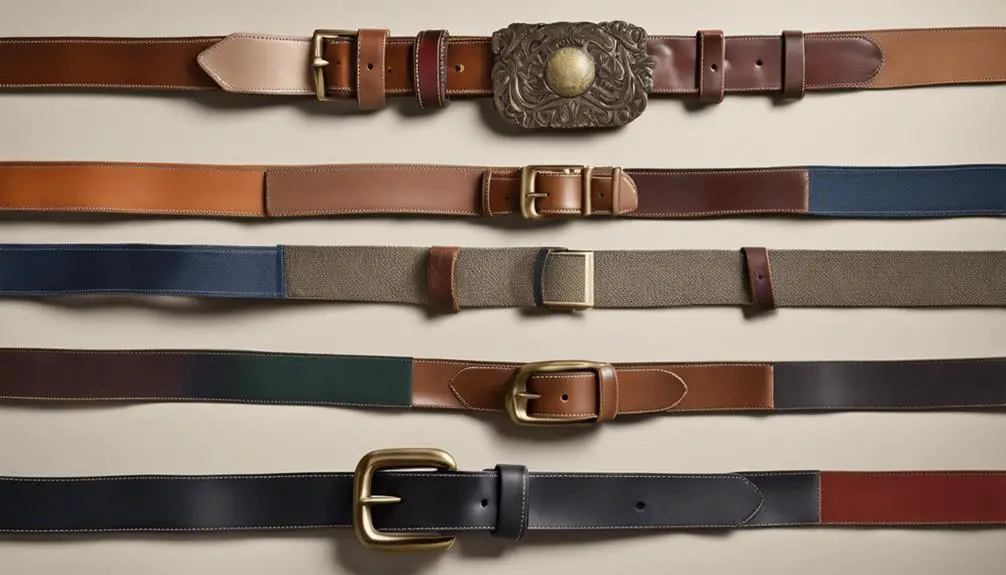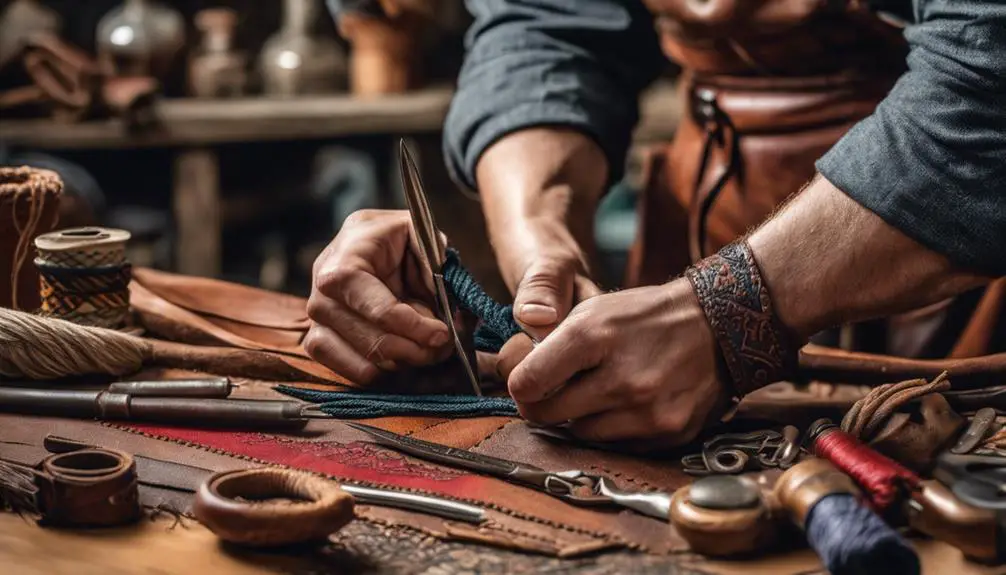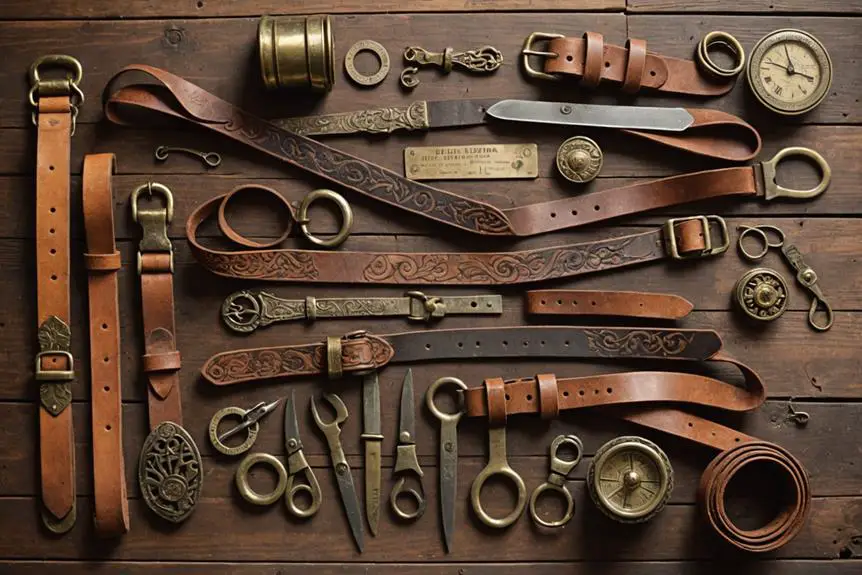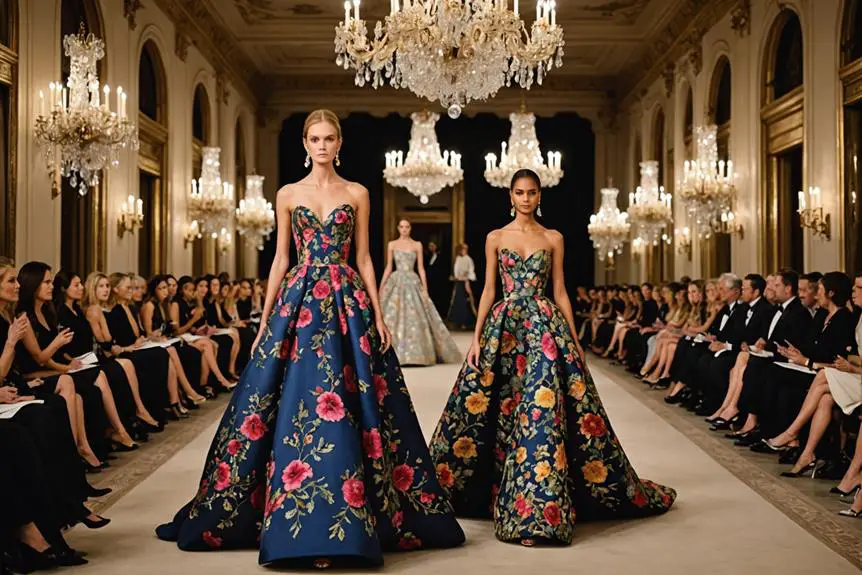Did you know that the world's oldest belt brands date back nearly two centuries? Brands like Hermès and Louis Vuitton not only pioneered luxurious designs but also set benchmarks for craftsmanship that many still aspire to today. Their iconic styles have shaped the way belts are perceived, blending functionality with high fashion. However, the story of these brands goes beyond mere aesthetics; it touches on evolving materials and cultural significance. What factors contributed to their enduring legacy, and how do they continue to influence modern fashion?
Historical Overview of Belts

Throughout history, belts have played an indispensable role in both function and fashion. Dating back to the Bronze Age, belts were invaluable for practical uses such as carrying tools and weapons, while also serving as stylish accessories. The earliest belts, constructed from materials like plant fibers, leather, and cord, were crucial for supporting garments and facilitating the hanging of pouches or other items.
As civilizations evolved, so did the significance of belts. Military girdles emerged, particularly in ancient Rome, where soldiers wore belts as part of their armor to signify rank and provide support for their weapons. This military connection highlights how belts represented authority and strength.
During the Middle Ages, belts shifted into decorative items, signaling social status. Wealthy individuals donned elaborate designs that included precious materials, showcasing their affluence and distinct style.
By the time the Industrial Revolution rolled around in the 19th century, a seismic shift occurred. Mass production techniques made leather belts and other styles widely accessible, transforming them from luxury items into essential fashion accessories for various social classes.
Today, belts continue to straddle the line between utility and style. Whether you're cinching a dress or holding up a pair of pants, you're participating in a rich history that connects you to the past.
Iconic Belt Brands Through Time
When you think about iconic belt brands, you're stepping into a world where timeless craftsmanship meets innovative design.
From Hermès' luxurious "H" buckle to Gucci's trendy interlocking "G," these brands haven't only set fashion standards but also influenced cultural trends with their unique styles.
Each brand tells a story of quality and creativity, showcasing the rich legacy of belt-making that continues to inspire today.
Timeless Craftsmanship Legacy
Belt brands that have stood the test of time exemplify the art of craftsmanship, blending tradition and modernity.
These labels, such as Hermès and its iconic Constance belt, showcase timeless craftsmanship and high-quality leather goods that are the epitome of luxury and quality. Since 1837, Hermès has delivered exquisite belts that reflect meticulous attention to detail, ensuring each piece is a work of art.
Gucci, established in 1921, revolutionized the market with its signature GG logo belt, merging modern style with traditional Italian craftsmanship, creating a statement piece that remains popular today.
Similarly, Louis Vuitton, since 1854, has produced belts adorned with its distinctive monogram canvas, which signifies luxury and durability.
Prada joined the scene in the 1980s, emphasizing clean lines and high-quality materials in its designs, perfectly resonating with contemporary fashion sensibilities.
Meanwhile, Saddleback Leather focuses on artisan-crafted leather belts, offering a 100-year warranty to emphasize durability and unique design, inspired by traditional craftsmanship practices.
These brands not only represent fashion but also a legacy of timeless craftsmanship that continues to inspire and captivate.
Notable Brand Innovations
Fashion enthusiasts recognize that innovation is key to the enduring appeal of iconic belt brands. Throughout history, notable brand innovations have transformed belts from simple accessories into essential fashion staples.
For instance, Hermès, founded in 1837, revolutionized the luxury belt market with its exquisite craftsmanship and the introduction of the "H" buckle, which quickly became a symbol of status and sophistication. Similarly, Gucci, established in 1921, made waves in the 1960s with its interlocking "GG" logo buckle, solidifying its reputation in high fashion.
Prada, since its inception in 1913, challenged conventional materials by incorporating nylon into its designs, introducing a modern aesthetic that reshaped perceptions of belts. More recently, Beltology emerged in 2012, focusing on casual belts crafted from stretchy, comfortable materials, blending style and functionality to appeal to today's consumers.
Coach, well-known for its high-quality leather goods since 1941, gained recognition in the 1980s for signature belt styles that perfectly balanced practicality and fashion, showcasing their commitment to craftsmanship.
Each of these brands demonstrates how innovation not only enhances functionality but also elevates the fashion experience, making belts an essential accessory in any wardrobe.
Cultural Influence on Designs
Embracing diverse cultural influences, iconic belt brands have continually evolved their designs to reflect societal values and aesthetics. When you think about wearing a belt, it's no longer just a functional accessory; it's a powerful fashion statement.
Brands like Gucci and Louis Vuitton have transformed belts into symbols of luxury, showcasing exceptional craftsmanship and unique ornamental designs that signify social status.
Military aesthetics also play a role in modern belt design. For instance, Saddleback Leather emphasizes durability and functionality, drawing inspiration from historical utility belts, making them perfect for those who appreciate rugged style.
In contrast, traditional Japanese obi belts highlight cultural significance, featuring intricate craftsmanship that has inspired global fashion trends.
As we move toward a more eco-conscious society, contemporary belt brands are embracing sustainability, merging traditional craftsmanship with eco-friendly materials. This cultural shift reflects a growing awareness of our environmental impact while maintaining a commitment to style.
Evolution of Belt Materials

When you look at the evolution of belt materials, you'll notice a fascinating journey from the natural fibers and hides of ancient civilizations to the innovative options available today.
The shift during the Industrial Revolution brought leather and synthetic materials to the forefront, making belts not just functional but also fashionable.
Now, with exciting advancements like eco-friendly alternatives and 3D printing, you can enjoy a belt that's not only stylish but also tailored to your unique tastes and values.
Historical Material Choices
Throughout history, belts have undergone a remarkable evolution in their material choices, reflecting both practical needs and cultural shifts. The earliest belts were made from natural materials like plant fibers, tree bark, and animal hides, primarily serving utilitarian purposes in ancient civilizations.
As time progressed, leather became the predominant material, celebrated for its durability and flexibility, particularly favored by Greek and Roman military personnel. During the Middle Ages, belts introduced decorative elements, with artisans crafting leather adorned with metals and gems to signify status among nobility and knights, making them symbols of wealth and power.
The Industrial Revolution brought a significant change, marking a shift toward mass production. This alteration led to standardized leather and synthetic materials, making belts more accessible to the general working class.
The ability to produce belts on a large scale not only revolutionized fashion but also democratized style, allowing everyone to enjoy the practical and aesthetic benefits of this essential accessory.
As you explore the rich history of belts, you can appreciate how material choices have evolved to meet the needs and desires of society, shaping the accessories we wear today.
Modern Sustainable Innovations
In recent years, a notable shift in belt materials has emerged, focusing on sustainable innovations that cater to environmentally conscious consumers.
You'll find a variety of sustainable options available, including belts made from recycled plastics, organic cotton, and plant-based leathers, all designed to reduce environmental impact. Eco-friendly leather alternatives, like mushroom leather and Piñatex, are gaining traction due to their biodegradability and lower carbon footprint compared to traditional leather production.
Brands are increasingly adopting sustainable practices by sourcing materials from certified suppliers and utilizing vegetable tanning processes, which avoid harmful chemicals, making them a healthier choice for the planet.
Additionally, the rise of 3D printing technology enables the creation of custom belts that use biodegradable materials, allowing you to express your unique style without contributing to excess waste.
Innovations in production processes, such as using less water and energy, have led to a decrease in the overall ecological impact of belt manufacturing.
With these advancements, you can sport a stylish belt while supporting a greener future, ensuring that your fashion choices align with your values as an environmentally conscious consumer.
The future of belts isn't just stylish but sustainable!
Cultural Significance of Belts
Belts often serve as powerful symbols of cultural identity and social status across various societies. Historically, belts were primarily used to signify rank and authority, especially in ancient civilizations like Egypt and Mesopotamia. These early belts indicated social hierarchies, often adorned with jewels to reflect wealth and power.
In Mongolia, belts hold a special place in diplomatic relations, exchanged as a means of carrying alliances that strengthen social bonds.
In contemporary culture, belts still carry substantial cultural significance. For instance, in martial arts, colored belts represent different skill levels, marking personal achievement and progression within that discipline. This tradition not only motivates practitioners but also reflects their dedication and hard work.
Similarly, traditional belts like the Japanese obi are integral to cultural attire, enhancing identity and customs in various societies.
Beyond fashion, belts have played crucial roles in rituals and ceremonies, marking significant milestones and achievements throughout history. From military uniforms, where they exemplify discipline and unity, to utility belts that serve practical purposes, belts are multifaceted accessories that enhance both function and style.
They've evolved into essential fashion items that can express individuality while maintaining their rich cultural roots. As you explore the intricate world of belts, you'll discover how they weave together history, identity, and social connections, making them more than just a wardrobe staple.
Craftsmanship in Belt Making

Exceptional craftsmanship in belt making transforms a simple accessory into a work of art. When you consider the meticulous processes involved, it's easy to appreciate how high-quality belts become treasured pieces. Skilled artisans often work with full grain leather, which retains the top layer of the hide, ensuring maximum durability and allowing a rich patina to develop over time. This attention to detail not only enhances the aesthetic appeal but also contributes to the longevity of the product.
Artisanal brands emphasize traditional methods, such as vegetable tanning, a process that can take 6 to 8 weeks, resulting in leather that's both strong and sustainable. By choosing to source leather from older bulls, these craftsmen produce thicker, more resilient hides, reducing waste and promoting ethical practices in leather production.
Customization is another hallmark of high-quality craftsmanship in belt making. You can select personalized designs, adjustable fittings, and unique buckle styles that cater to your individual preferences. Whether it's a classic look or a trendy statement piece, the options are endless.
Moreover, quality belt makers, like Saddleback Leather, enhance their products with hardware made from high-grade materials, such as 316 stainless steel, ensuring that every detail is crafted for durability.
Contemporary Trends in Belt Fashion
As craftsmanship continues to shape the belt-making landscape, contemporary trends are redefining how these accessories are viewed in fashion. Today, belts became more than just functional items; they embody a blend of style and practicality.
With the rise of athleisure, innovative belt styles have emerged, offering freedom of movement for fitness enthusiasts. Adjustable and smart belts cater to those who value flexibility and durability while staying stylish.
Sustainability is also a significant trend. Eco-friendly materials are gaining traction, reflecting your desire for accessories that aren't only chic but also ethically produced. Brands are innovating by incorporating recycled materials, proving that fashion can be mindful of the planet.
Customization is another key aspect of contemporary belt fashion. You can now find a variety of types of belt that allow for personalization, letting you express your unique style. From heavy-duty options to elegant leather designs, the choices are endless, ensuring that every outfit can be perfectly complemented.
High fashion brands are transforming belts into statement pieces, utilizing unique materials and intricate designs that elevate their aesthetic appeal beyond mere utility.
Whether you're dressing up for a formal occasion or keeping it casual, the right belt can make all the difference. With so many trends at play, it's easy to see how contemporary belt fashion continues to evolve, exciting you to explore new styles and innovations that suit your lifestyle.
Frequently Asked Questions
What Is the Earliest Known Belt?
Imagine slipping into the past; the earliest known belt, crafted from leather, showcases ancient accessories' historical significance. It symbolizes cultural innovation and fashion evolution, reflecting artisans' craftsmanship and belt technology during its time.
Who Made the First Belt?
You'll find that the first belt's creation involved artisan craftsmanship, using materials like leather. Its historical significance spans ancient uses for function and symbolism, evolving into diverse cultural variations with decorative fasteners reflecting fashion trends.
What Belts Were Popular in the 2000S?
In the 2000s fashion scene, you'd rock wide leather options or casual belts with vibrant colors. Statement accessories from designer styles mixed with vintage trends, creating a unique blend of boldness and laid-back flair.
What Type of Belts Were Popular in the 90S?
In the 90s, you'd rock leather styles with oversized buckles or embrace grunge fashion's colorful straps and vintage designs. Utility belts and chain belts became statement pieces, blending practicality with bold fashion choices.





Hey I know this is off topic but I was wondering if you knew of any widgets I could add to my blog that automatically tweet my newest twitter updates.
I’ve been looking for a plug-in like this for quite some time and was hoping maybe you would have some experience with something like this.
Please let me know if you run into anything. I truly enjoy reading your blog and I look forward to your new updates.
casino en ligne
I’d like to thank you for the efforts you’ve put in writing this blog.
I really hope to check out the same high-grade content from you later on as
well. In truth, your creative writing abilities has motivated
me to get my own website now 😉
casino en ligne
Do you mind if I quote a couple of your articles as long as I provide credit and
sources back to your weblog? My blog site is in the very same niche as yours and
my visitors would genuinely benefit from a lot of the information you provide here.
Please let me know if this okay with you. Many thanks!
casino en ligne France
Hey very cool site!! Guy .. Excellent .. Wonderful .. I will bookmark your website and take the feeds also?
I’m satisfied to search out so many useful info here within the post,
we need develop extra strategies in this regard, thanks for sharing.
. . . . .
casino en ligne
Hmm is anyone else encountering problems with the pictures on this blog loading?
I’m trying to figure out if its a problem on my end
or if it’s the blog. Any suggestions would be greatly appreciated.
casino en ligne
It’s truly very difficult in this full of activity life to listen news on TV, therefore I only use
the web for that purpose, and obtain the most recent news.
casino en ligne France
Hey I know this is off topic but I was wondering if you knew of any widgets
I could add to my blog that automatically tweet my newest twitter updates.
I’ve been looking for a plug-in like this for quite some time and was hoping maybe you would have some
experience with something like this. Please let me know if
you run into anything. I truly enjoy reading your blog and I look forward to
your new updates.
casino en ligne France
Hi everyone, it’s my first pay a visit at this website, and piece of writing is in fact fruitful in support of me, keep up posting these types of articles.
casino en ligne fiable
Hi there are using WordPress for your blog platform? I’m new
to the blog world but I’m trying to get started and create my
own. Do you need any html coding knowledge to make your
own blog? Any help would be greatly appreciated!
casino en ligne
whoah this weblog is excellent i love reading your
articles. Stay up the good work! You understand, many individuals are
searching around for this information, you can aid them greatly.
casino en ligne